#Duke of Saxony
Explore tagged Tumblr posts
Text

Otto I, Holy Roman Emperor, invading Italy. By Tancredi Scarpelli.
#tancredi scarpelli#heiliges römisches reich#otto I.#kaiser#die deutschen kaiser#kaisersaal#holy roman emperor#holy roman empire#regno d'italia#re d'italia#otto the great#emperor off the romans#king of italy#King of East Francia#duke of saxony#ottonian dynasty#lithograph
4 notes
·
View notes
Text
me if i were the duke of saxony visiting germany in 1620: heyyy what is up my lieges any chance i can see wherefore thou maketh the tin cans? not for any reason though i promise
me if i were the duke of saxony returning to england in 1620: thou willst NEVER believe this!!!!
6 notes
·
View notes
Link
Magnus was the duke of Saxony from 1072 to 1106. Eldest son and successor of Ordulf and Wulfhild of Norway, he was the last member of the House of Billung.
Link: Magnus, Duke of Saxony
0 notes
Text

All the blossoms in my garden 🪴
An Angevin-Plantagenets family tree I made for my medieval art collection zine, “If All The World Were Mine!” The physical edition is now available, so check it out if you can :D
#the plantagenets#plantagenets#medieval#12th century#geoffrey of anjou#geoffrey plantagenet#Matilda of england#matilda lady of the english#henry ii of england#eleanor of aquitaine#henry the young king#matilda duchess of saxony#richard the lionheart#geoffrey duke of brittany#eleanor of castile#joanna of sicily#john lackland#john i of england#richard i of england#louis vii of france#philip ii of france#philip augustus#whew thats a lotta names#melusine#my art#family tree
75 notes
·
View notes
Text

The Ducal Wittelsbach family and their relatives, early 1890s. From left to right, standing: Karl Theodor, Duke in Bavaria, Duchess Elisabeth in Bavaria, Archduchess Elisabeth Amalie of Austria, Duchess Sophie Adelheid in Bavaria, Archduchess Maria Annunziata of Austria, Princess Maria Immacolata of Bourbon-Two Sicilies, Duchess Marie Gabrielle in Bavaria.
Sitting: Archduchess Maria Teresa of Austria (née Infanta of Portugal), King Francesco II of the Two Sicilies, Queen Marie Sophie of the Two Sicilies (née Duchess in Bavaria)
Via As Infantas de Bragança e a Sua Descendência - História das Filhas de D. Miguel by Dativo Salvia Ocaña
#look what i found completely by chance! the quality isn't very good because it's from the book's preview#francesco died in december of 1894 so the picture is from before that date#but definetly 1890s because. puff sleeves#(also the author misidentifies maria teresa as her sister maria josé and maria annunziata as mathilde countess of trani)#karl theodor duke in bavaria#queen elisabeth of the belgians#elisabeth amalie of austria princess of liechtenstein#sophie in bavaria countess of toerring jettenbach#archduchess maria annunziata of austria#maria immacolata of bourbon-two sicilies princess of saxony#marie gabrielle in bavaria princess of bavaria#maria teresa of braganza archduchess of austria#francesco ii of the two sicilies#queen marie sophie of the two sicilies#house of wittelsbach#house of bourbon two sicilies#house of braganza
27 notes
·
View notes
Text
youtube
Man, I just love finding out how much the Europeans have lied about the presence of Black people in their history. Queen Elizabeth, Walsingham, Black German nobility, Black Scottish nobility, Black Jacovites. Outlander is a lie, and so much more. It's no wonder racists like #GregAbbott go after Black Hair. It reminds them of what they worshipped.
#Queen Elizabeth#Walshingham#Philip the second of Spain#John George and Augustus#Electors of Saxony#Charles Duke of Somerset#James Vernon Esq#Black Nobility of Europe They Tried To Hide#Youtube
0 notes
Text
Steel Brocade: Puffed & Slashed Costume Armor
Surviving to this day in the collections of the world’s most illustrious museums are a group of three armors. These armors have much in common, but most striking is the attempts made by their armorers to render in steel a convincing portrayal of the puffed and slashed clothing fashionable to the early 16th century.
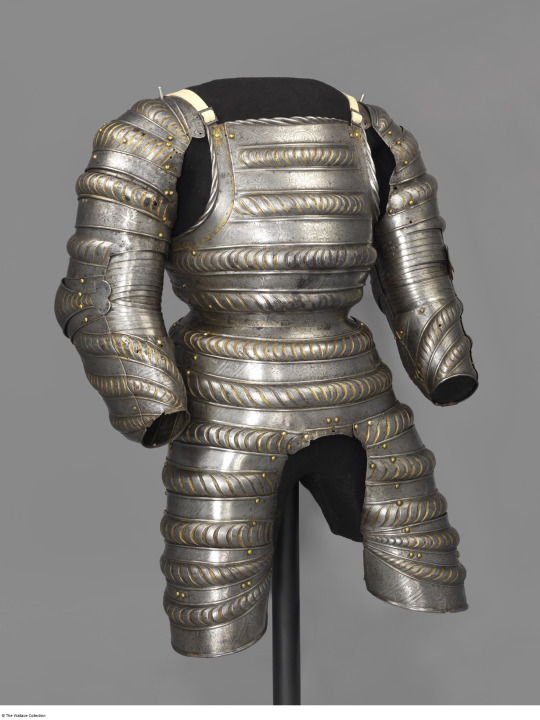

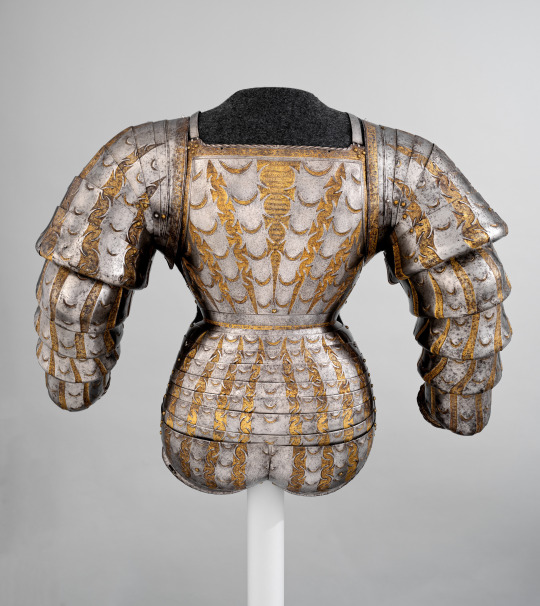
Though this fashion is synonymous with the landsknecht mercenaries who may have been responsible for popularizing it, the puffed and slashed style was enjoyed by members at all levels of society.

Portrait of Duke Henry of Saxony by Lucas Cranach the Elder, 1514, Staatliche Kunstsammlungen, Dresden.
The earliest of these three armors is housed at the Wallace Collection. Consisting only of a cuirass and arms, this armor is, at first glance, rather underwhelming when compared with the other armors in this group. Though the embossed bands styled with etched slashes embellished with gold provide the impression of a puffed and slashed doublet, the execution is all rather stiff, and lacks the impressive volume and fullness exemplified by the other armors.

It is for this reason that this armor, previously considered contemporary to the KHM and Metropolitan examples, has received relatively little attention. However, recent scholarship by Dr. Tobias Capwell suggests that this work is not, indeed, contemporary to the other examples, and is rather about ten years older, dating to ca. 1515. Dr. Capwell also considers this piece to be the work of Konrad Seusenhofer, a favored armorer of the Emperor Maximilian I.
Seen through this lens, not as a poorly executed contemporary of greater armors, but as a less developed ancestor to them, this armor takes on new life. It speaks to innovation and experimentation; an early attempt at a technique which would later be perfected.
The second in this line is the garniture of Wilhelm von Rogendorf, housed at the Kunsthistorisches Museum in Vienna.

This armor is unique for its condition, which is remarkably good. Not only does this armor retain more of its pieces than the other two, it is also accompanied by a number of “pieces of exchange,” elements which could be swapped out so the armor could be worn in the field.
Finished in 1523, as attested to by the date etched on the right shoulder strap, this armor was made for the Count Wilhelm von Rogendorf by Kolman Helmschmid and etched by Daniel Hopfer.

Wilhelm von Rogendorf himself was heir to a new, up-and-coming German noble family.

A medal showing Wilhelm von Rogendorf as a Knight of the Order of Calavatra, dated 1536, Kunsthistorisches Museum, Vienna.
Born in 1481 the second son of Kaspar von Rogendorf, Wilhelm became heir to his family’s estates when his elder brother Sigmund died in 1507, by which time Wilhelm was already a courtier at the Habsburg court. He entered into the service of King Charles I of Spain (later Emperor Charles V) no later than 1517 and was appointed Governor of Friesland. In 1522, Wilhelm accompanied Charles to Spain where he commanded a regiment of 4,000 landsknechts and was again placed in charge of a restless border territory. In 1524, he successfully captured the Fortress of Fuenterrabía from the French, which won him great praise from the Emperor. Shortly thereafter, Wilhelm was named Captain of the Imperial Bodyguard and given the governorships of Catalonia, the Cerdagne, and the Roussillon. Additionally, he was appointed to the Spanish chivalric Order of Calavatra. Wilhelm would retire from court in 1539, but would be recalled in 1541 to command Imperial troops against the Ottomans in Hungary. He would be killed later that same year at the siege of Buda by a stray cannonball.
Though Wilhelm’s armor is now displayed in its parade configuration, the surviving pieces of exchange attest to the fact that it was also an armor for combat. The cuirass is equipped with the long tassets common to the early 16th century. A pair of holes can be observed at the top of the last lame.

These holes correspond to holes at the top of the half-cuisses which accompany this armor, showing that these cuisses would be pointed to the tassets rather than worn separately.

In the rear, the cuirass is accompanied by a rump-defense, also known as a hoguine. Small turning pins near the waist allow this to be removed for combat.
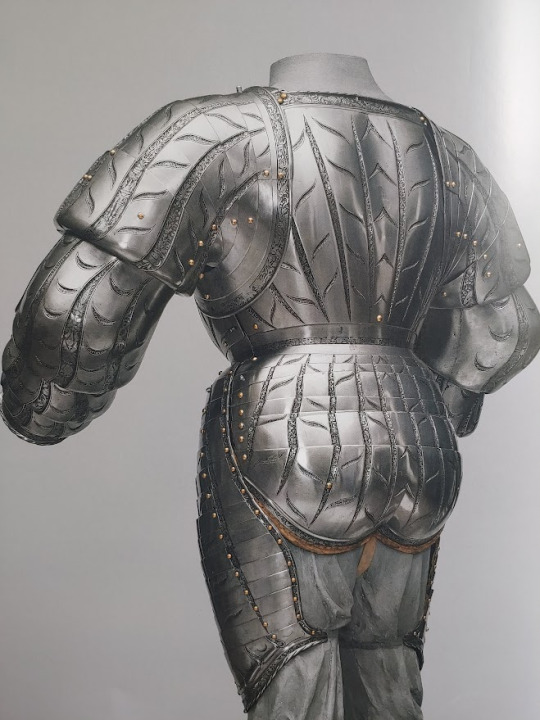
Both spaulders
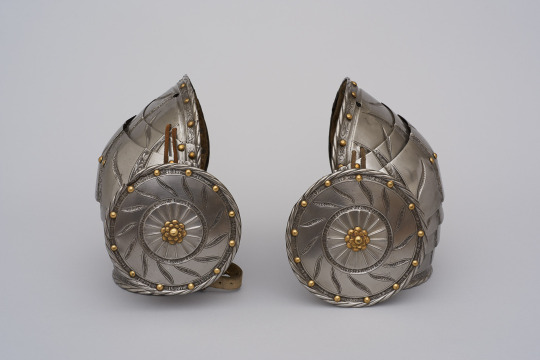
and gauntlets

survive. Additionally, the KHM retains the armor’s right vambrace
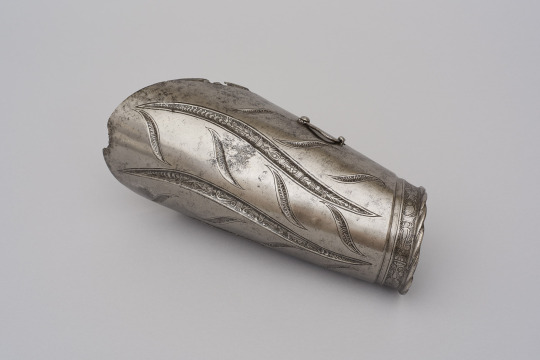
while the Wallace Collection holds the rerebrace and couter for the left arm.
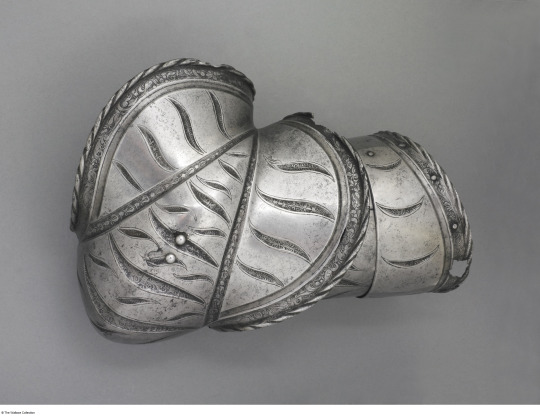
Recently, these pieces were assembled to show what the arm harness for field as a single unit would have looked like.
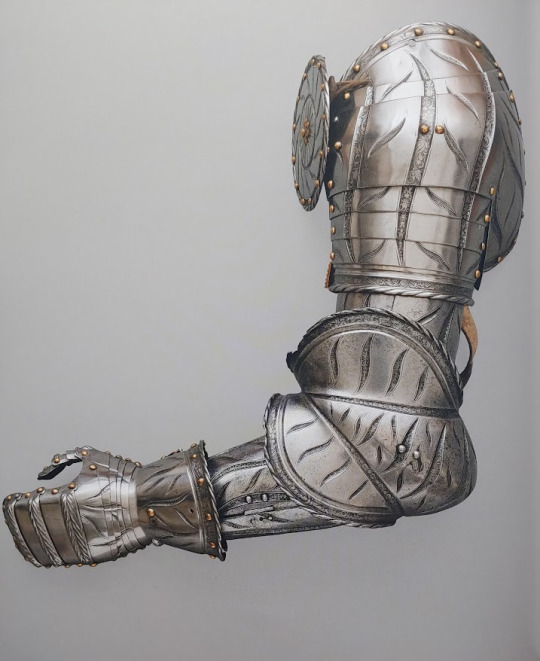
This armor would also have been accompanied by a gorget, now missing, and a helmet. Frequently, this armor is displayed alongside a close-helmet, however it is more likely the armor would have been accompanied by a burgonet similar in form to this example from the KHM.
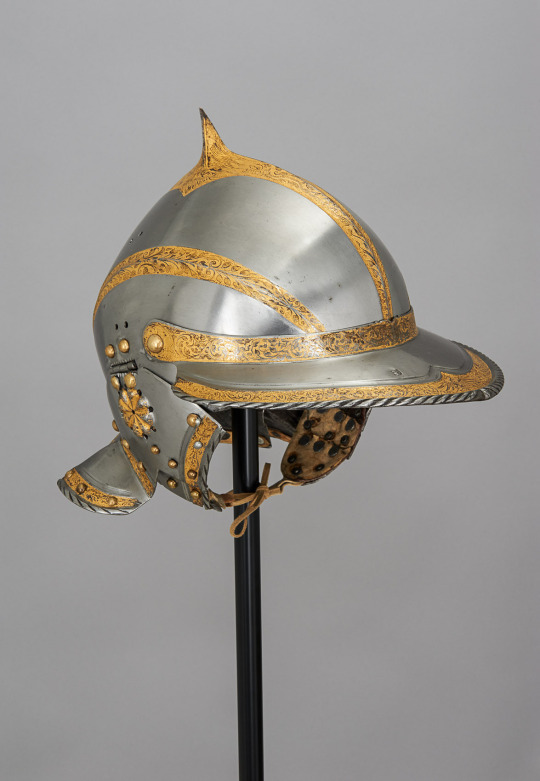
One final, unique surprise this armor holds is a hidden lance rest which is incorporated into the turned edge by the right arm. This rest folds down to allow a light lance to be braced atop it, and when folded up, is nearly invisible so as to not ruin the smooth surface of the breastplate with the prominent staples typically required for affixing a lance rest.

The third and final armor of this group is housed at the Metropolitan Museum of Art in New York City.

The least complete of these three armors, it may also be the most visually impressive. Comprised of only a backplate, hoguine, and arms, the puffs and slashes of this piece (also by Kolman Helmschmid and Daniel Hopfer) are ornately cusped. The slashed regions, displaying the gilded “fabric” beneath, and heavily etched to resemble an expensive silk brocade.
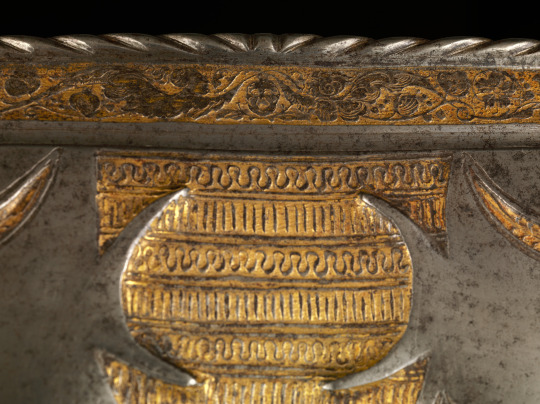
The sleeves of this armor are even more voluminous than those of the Rogendorf armor, though they are similarly articulated and provide the wearer with a surprising degree of mobility. It is thought that this armor may have been made for prominent Polish nobleman Jerzy Herkules Radziwill.
Interestingly, the hoguine of this armor is composed of two separate plates, rather than a single solid plate. Where the hoguine of the other two armors terminates in a decorative fabric border, the Met armor continues into two more articulated lames, covering the top rear of the thighs. Holes along the bottom edge suggest that this armor may have been accompanied by fully enclosing cuisses which pointed to the bottom of the fauld and hoguine.
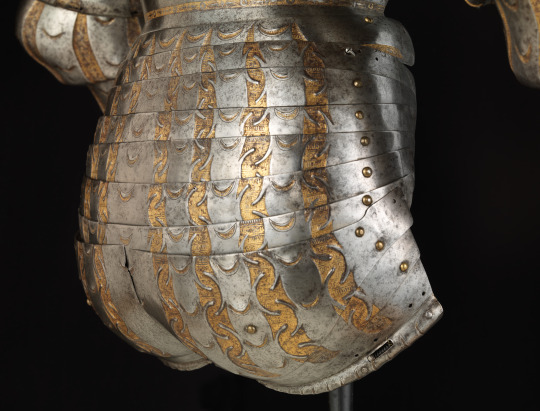
Sources
“A Pair of Gauntlets.” Kunsthistorisches Museum Wien. https://www.khm.at/de/object/540164/.
“A Pair of Spaulders with Besagews.” Kunsthistorisches Museum Wien. https://www.khm.at/de/object/372772/.
Cranach, Lucas the Elder. “Portrait of Duke Henry of Saxony.” Staatliche Kunstsammlungen Dresden. https://skd-online-collection.skd.museum/Details/Index/246875.
Krause, Stefan. Fashion in Steel. Vienna: Kunsthistorisches Museum, 2017.
“Landsknecht Costume Armour.” Kunsthistorisches Museum Wien. https://www.khm.at/de/object/372771/.
“Left Upper Cannon and Couter.” The Wallace Collection. https://wallacelive.wallacecollection.org:443/eMP/eMuseumPlus?service=ExternalInterface&module=collection&objectId=60736&viewType=detailView.
“Open Burgonet.” Kunsthistorisches Museum Wien. https://www.khm.at/en/object/503346/.
“Parts of an Armour.” The Wallace Collection. https://wallacelive.wallacecollection.org:443/eMP/eMuseumPlus?service=ExternalInterface&module=collection&objectId=60519&viewType=detailView.
“Portions of a Costume Armor.” The Metropolitan Museum of Art. https://www.metmuseum.org/art/collection/search/27790.
“Vambrace.” Kunsthistorisches Museum Wien. https://www.khm.at/de/object/372773/.
“Wilhelm von Rogendorf.” Kunsthistorisches Museum Wien. https://www.khm.at/de/object/1409642/
.
#long post#armor#armour#landsknecht#costume armor#art#history#renaissance#germany#german#hre#holy roman empire#europe#european#themet#metmuseum#khm#skd#wallace collection
1K notes
·
View notes
Note
Any books that shows us out right that Mordred could actually be a good, or at least capable ruler?
Hi! I’m gonna suggest medlit as well as retellings for you.
Medieval Literature
The History of the Kings of Britain by Geoffrey of Monmouth
Modred is present here for only a little while, but he comes in hot. He’s considered “boldest of men” in his audacity against Arthur. He marries Queen Guanhumara [Guinevere]. Modred's army is huge in part because he welcomes Christians & Pagans to his ranks. He's skilled at war & although Arthur overwhelms him tp retreat repeatedly, he's quick to return the attack each time. In the end, he makes a final push to "either conquer or die." So a decidedly brave & savvy Modred if not a successful one.
Vulgate
Mordred has the most depth here of any medieval story simply because this gives him the most page time of all. He's very clever in his wording when he joins Agravain to tell Arthur of Guenevere's infidelity. He says, "We’ve concealed this from you as long as we could; but now the truth must be known, and we must tell it; and by hiding it from you for so long, we’ve been deceitful and disloyal to you. Now we’re doing our duty." Mordred's quick tongue continues to aid him even after all his brothers but Gawain had died. He ends up with Arthur's entire treasury plus an army of soldiers oath-bound to him. After falling in love with Guenevere, Mordred's people encourage her to marry him, saying, "We know of no knight more worthy to rule an empire or a kingdom, for he is a valiant man and a good and courageous knight." It's stated that many nobles "invested" in Mordred & provided him even more wealth as they believed in his cause. He also got Saxony to pay tribute, which Arthur had failed to do.
La Tavola Ritonda | Italian Name Guide
Mordarette [Mordred] is first shown to be really competent as King Artù [Arthur] makes him a viceroy, messenger, & army commander alongside his cousin Ivano [Yvain] in the same way Calvano [Gawain] was in the Vulgate. After that, while Artù & Calvano have run off to battle Lancelotto [Lancelot], Mordarette is left behind as "viceroy & king." He took that to heart & attempts to marry Ginevara [Guinevere]. It's stated that Mordarette's people "Swore to stay by him and never abandon him because of King Mordarette's great joyfulness and courtesy."
Alliterative Morte Arthure
Iconic. This is the prime example I think of when I consider capable ruler Mordred. Arthur has gone all around the world wielding Excalibur to battle & acquire more & more territory. He leaves Mordred behind to essentially rule in his place, even though Mordred begs to come & win himself honor. Arthur leaves & is gone so long that Mordred just… assumed the kingship. He & Guinevere marry, have children, & Guinevere shows Mordred where to find Arthur’s other sword, Clarent. Eventually it comes to blows but Mordred's following is exceedingly loyal as it's been so long that Arthur's return feels like an invasion! Mordred had appointed all new dukes & earls that were loyal to him, & filled out his army with Pagans that Arthur had previously shunned. The ending battle is epic & really showcases what a great fighter Mordred is. He leads his men by example.
Retellings
Mordred: A Tragedy by Henry Newbolt
Mordred play of all time. After Mordred reveals to Agravaine that he’s Arthur’s son, he manages to get all 4 of his elder brothers to support his claim to the throne. He speaks of freedom & truth—he really thinks he’s doing the right thing, & successfully canvasses his case to many. He rides this mindset all the way to the end with an army equal to Arthur’s, they each lose the same number of folks on each side, despite Mordred jumping between them to try & prevent the charge. Incredible piece of literature. Wish I could see it on stage.
Arthur The Bear of Britain by Edward Frankland
The oldest Welsh-inspired retelling I have & likely a huge inspiration for much of what came after. Medraut is just a year younger than his uncle Arthur, not as big or strong as Arthur, Kai, Bedwyr, or Gwalchmai, but he's cunning, & a skilled harper who uses music for political gain. He falls in love with Gwenhyvar & fantasizes about what a better husband he would be to her, & in turn, a better guardian of the land. (This book has by far the most Gwenhyvar of all the Welsh-inspired retellings on the list, so that's a huge bonus.) Medraut has contrasting ideas about how to handle the Saxons & Engels, as he sees they have integrated into society & had children with Britons, so he reckons to fight them is to fight themselves. Arthur disagrees & wants to see them all slaughtered or expelled. This causes a rift that worsens throughout the story & culminates in their split, with Medraut amassing an army efficiently as Arthur can combat him.
The Queen's Knight by Marvin Borowsky
Mordred is a warlord & the major opponent of Arthur as he rises to power. Many fear Mordred because of his military prowess & successful campaigns. He's formidable & clever. Later in the book, after a peace agreement, he basically goes sleeper agent & pretends to be chill for many years biding his time until he can land the final blow against Arthur & be king. Fascinating character & I love the writing style. Content warning for pederasty between Mordred/youth.
The Great Captains by Henry Treece
Medrodus or Medrawt is the "younger brother" of Artorius, the Count of Britain, who doesn't receive the legendary sword Caliburn from Uther. Medrodus is by rights entitled to the role that Artorius has won for himself, but ends up his confidant & a general alongside Cei & Bedwyr. After being initiated into the Celtic way of life, Medrawt, as he's then known by, slowly learns of war from his superiors & wrestles with his conflicted feelings about Artos's position, believing him both capable & incompetent, cruel & kind as a leader. His harbored doubts fester over the years until Medrawt at last makes his move with the skills & allies he accumulated in that time. The "brothers" eventually clash as is expected but nothing can prepare you for the ending. Content warning for incest between Artos/Gwenhwyfar.
The Green Man by Henry Treece
Treece loved Arthurian legend so much, that 10 years after The Great Captains, in the year of his death, he published his final book The Green Man, which tells the whole story over again but differently. Medraut is a son of King Lot of Orkney & nephew of Arthur the Bear. Instead of Roman, he's Pictish. But Medraut's once again subordinate to Arthur, distrusted by Kei & Bedwyr One Hand, & harbors a dislike for Arthur's leadership. I don't know whether I like this one better than The Great Captains, but it shakes things up, as Gwenhwyvar is Medraut's aunt by blood, his mother's sister, so Arthur is his uncle by marriage. This changes the dynamic considerably as the animosity between them stems from seeing Arthur as an outsider, rather than competition as in the first book. Medraut is on his same routine here making allies behind everyone's backs & plotting. He's a pro.
The Wicked Day by Mary Stewart
Mordred is shockingly normal considering the circumstances of his birth. His first impression of Arthur is when he's picking out a new puppy from the litter descended from Cavall. Arthur accepts him as his son immediately, but Mordred is haunted by the prophecy which dictates he'll inevitably be Arthur's "bane." Despite his legitimate respect & even love for his father, things spiral out of control, & Mordred is forced to take up arms against Arthur. Devastating resolution I fear I'll never recover.
The Book of Mordred & The Last Knight of Albion by Peter Hanratty
Mordred is introspective & philosophical. He's not incompetent as a fighter, but certainly of a stronger mind than body. The first book follows him from childhood as his worldview is shaped & corrupted by his treatment from Arthur's inability to handle his own son. The second book follows young Percival in the aftermath of Camlann. Mordred is in it but not as much of a focus, although Percival is determined to track him down & finish what the other knights of the Round Table started. Getting an outside perspective of Mordred is interesting. These books are a great example of unreliable narration.
A Camelot Triptych by Norris J. Lacy
Mordred in the third story in the triptych but all three together really paints an interesting picture of him as a person. He's a tortured soul who believes he meant well & ultimately became the evil thing everyone always believed him to be. The final portion is Mordred raving right before the battle of Camlann where he expresses his feelings regarding Arthur's tyranny & that he intends to martyr himself to save his country from it. Written by the guy who was head editor of the Vulgate so you know it's good.
That's what I got for ya!
There are definitely other examples I could squeeze in here. But these are the books I found most compelling and followed the story through to the conclusion so we get to actually see Mordred as a leader. This list offers a variety of interpretations, some drawing more heavily on on Welsh mythology while others pull lore exclusively from the French Vulgate. Honorable mention to Phyllis Ann Karr's Idylls of the Queen, which doesn't show Mordred as a competent leader, but sets up his motivations in a fascinating way. It's also just a damn good book.
Hope you find some stories among these that resonate with you. Many Mordreds to choose from! I'd love to hear from anyone who reads these and enjoyed them. Take care. :^)
#arthuriana#arthurian legend#arthurian literature#arthurian mythology#welsh mythology#sir mordred#mordred#medrawt#medraut#ask#anonymous#my post
51 notes
·
View notes
Text

Grand Duke Leopold II of Tuscany (1797-1870)
Artist: Ferdinand Georg Waldmüller (Austrian, 1793-1865)
Date: 1833
Medium: Oil on canvas
Collection: Kunsthistorisches Museum Vienna, Austria
Leopold II, Grand Duke of Tuscany
Leopold II[nb 1] (3 October 1797 – 29 January 1870) was Grand Duke of Tuscany from 1824 to 1859. He married twice; first to Maria Anna of Saxony, and after her death in 1832, to Maria Antonia of the Two-Sicilies. By the latter, he begat his eventual successor, Ferdinand. Leopold was recognised contemporarily as a liberal monarch, authorising the Tuscan Constitution of 1848, and allowing a degree of press freedom.
The Grand Duke was deposed briefly by a provisional government in 1849, only to be restored the same year with the assistance of Austrian troops, who occupied the state until 1855. Leopold attempted a policy of neutrality with regard to the Second Italian War of Independence but was expelled by a bloodless coup on 27 April 1859, just before the beginning of the war. The Grand Ducal family left for Bologna, papal territory since the Congress of Vienna.
Tuscany was occupied by soldiers of Victor Emmanuel II of Sardinia for the duration of the conflict. The Armistice of Villafranca, agreed to between Napoleon III of France and Franz Joseph I of Austria on 11 July, provided for the return of the Lorraines to Florence, but Leopold himself was considered too unpopular to be accepted, and on 21 July 1859, he abdicated the throne in favour of his son, Ferdinand. Ferdinand was not, however, any more acceptable to the revolutionaries in control of Florence, and his accession was not proclaimed. Instead, the provisional government proclaimed the deposition of the House of Habsburg (16 August).
#portrait#painting#oil on canvas#man#standing#full length#armour#leopold ii of tuscany#italian culture#velvet cape#royal crown#table#sword#helmet#velvet#italian history#grand duke leopold ii#ferdinand georg waldmüller#austrian painter#fine art#19th century painting#european art#artwork
28 notes
·
View notes
Text

Lucas Cranach the Elder - Henry IV the Devout, Duke of Saxony, Margrave of Meissen (1473-1541), half-length, in armor, with a two-handed sword
78 notes
·
View notes
Text

Gerberga of Saxony, Queen of West Francia, Duchess of Lotharingia
"Gerberga was unquestionably one of the pivotal figures in the dynastic politics of her age. Born around 913, she was a daughter of the east Frankish/Saxon king Henry I and sister of his celebrated successor Otto I “the Great”. She was not only a daughter and sister of rulers, but also a wife and mother. Her first marriage, probably contracted in 928, was to Giselbert, dux of Lotharingia, who died in 939 whilst rebelling against [her brother] Otto; and her second husband, acquired in the same year she lost her first, was the young Carolingian king Louis IV of West Francia, her junior by some six or seven years. Their son Lothar became West Frankish king in 954.
Gerberga’s royal upbringing and connections made her a potent figure throughout her career. While we have to be wary of an eleventh-century source which claims that she was the driving force behind Giselbert’s rebellion of 939 [by claiming that she was equal to her brother Otto and just as suited for the throne as he was], contemporary witnesses do confirm that she was at the duke’s side at key moments in his reign. Marriage to Louis, who was often at loggerheads with Otto, and consecration as West Frankish queen, created potential for divided loyalties (that they named their son Lothar hints at an ambition to take Lotharingia, which was part of the eastern kingdom), but Gerberga was instrumental in effecting an eventual rapprochement between the two rulers and enlisting her brother’s help against her husband’s internal enemies in the late 940s. [She was active in the defense of Laon and Reims, accompanied Louis IV on military expeditions to Aquitaine and Burgundy, and served as the effective head of state when the king was captured by the Normans in 945-946, with Duke Hugh the Great attempting to ensure that he would never be released. Gerberga refused to give up the West Frankish heir to Hugh and negotiated with her brother, Otto, who ravaged her enemies’ territories until they were forced to come to terms with Louis IV. When hostilities broke out again in 948 and Hugh attacked Laon, she led its defense. During the conclusion of the conflict in 953, it was Gerberga who renegotiated peace between Louis and Hugh, the latter of whom specifically requested for a meeting with her in order to set the diplomatic process in motion].
The high point of her role as a bridge between the eastern and western dynasties came during her widowhood, which saw her acting as a kind of regent for her young son Lothar. Lothar’s marriage in 966 to Otto's step-daughter Emma was planned with Gerberga’s active involvement and joined together the various branches of her family tree, placing her together with her brother at the apex of an extended European family of dynasties."
— Simon MacLean, "Reform, Queenship and the End of the World in Tenth-Century France: Adso’s “Letter on the Origin and Time of the Antichrist” Reconsidered" / Depiction in the Ottonian family tree in the Chronica St. Pantaleonis
#gerberga of saxony#historicwomendaily#10th century#Louis IV#french history#women in history#my post#carolingian period
22 notes
·
View notes
Text
The life and time of Nickolous Arc knight of Pitton
a continuation of Jaune's family line, this is a little bit before the reign of Uther Pendragon. Last time we left off Great Grandpa Arc was killed in the night of long knives by the treacherous saxions and Vortigern. his son Nickolous was knighted and inherited the manor at Pitton he married very well and won himself the daughter of a duke in 464.
Year 465 Vortigern, with his Saxons, marches back and forth across Britain, extracting tribute and plunder. Many more Britons flee the land. Nickolous, a young knight, remains in his lands, tends to his manor, and waits with his lord. Vortigern takes refuge in Gomeret, attempting to build a fortress. The youthful Merlin makes his appearance and begins his career here.
Years 466–467 Aurelius Ambrosius, son of the former King Constantin and brother of Constans, lands in Hampshire with an army from Brittany. He carries a great banner with a red dragon upon it. All across the land, discontented nobles muster their armies and join him. Vortigern seeks to escape, but his Saxon allies go back home to Kent, and many other allies desert him. After besieging a portion of Vortigern’s army at Carlion, Aurelius Ambrosius marches through the entire island, accepting the submission of those loyal to Vortigern.
Nickolous fought and died gloriously in this battle earning himself 1000 glory leaving behind a widow and a three-year-old son. (oof tough luck but at least he went out well.) his son Roland Arc would live through the following events without the protection and care of a father. Year 468
Aurelius Ambrosius and his army pursue Vortigern and besiege him in his new castle on Mount Snowdon. A battle ensues, at which Vortigern is killed and his army scattered. Aurelius Ambrosius summons the High Council, and they elect him High King. He takes the title of Pendragon (“high dragon” or “head dragon”), derived from his great battle banner.
Years 469–472 Many Saxons come over from the Continent and settle in Kent under their king, Hengest. High King Aurelius Ambrosius maintains an unsteady peace with the Saxons, Irish, and Picts, despite their raiding. His younger brother, Uther, makes a name for himself as a great warrior in countering these raids and leading picked warriors on raids into enemy territory.
Year 473 The Saxons, confident of victory, march into the Thames Valley. King Aurelius Ambrosius raises an army to resist, but loses the battle in a major Saxon victory
Year 477 Another Saxon king, Ælle, lands in southern Britain with a large army and takes over the area. Many of the peasants flee, but others are captured and enslaved. Ælle renames the land South Saxony, or Sussex. Aurelius Ambrosius marches with his army to oppose the foe, who is reinforced at the last moment by the Saxons from Kent. Ambrosius is lucky to escape with his army. The Saxons remain.
Years 478–479 For years, Aurelius Ambrosius has been building a fleet of ships in the ports of his western lands. In this year, he musters his army and sets sail, sweeping around the southern coast, where he destroys the fleets of the Saxons in Britain. Then he sails to the Continent, destroying all the hostile shipping as he goes. The British army lands in Frisia, doing great damage to the Saxons there, and winning a battle against the barbarians. The Saxons in Britain begin vicious raiding in retaliation.
Year 480 An army of Saxons sails up the Port River into Salisbury. While planning for the battle, Aurelius Ambrosius is poisoned by a false doctor. Despite his illness, Ambrosius marches with Uther against the enemy, whom they meet at Menevia. Ambrosius confronts the foe while Uther takes his army around to the Saxons’ rear and cuts them off from their ships, attacking them with great vigor. It is a great victory for the British, but Ambrosius is killed in the fighting.
Years 481–483 The Saxons are relatively quiet during this time, with small bands raiding here and there but no armies marching. It is reported that many of their women and children have now settled in their lands.
Year 484 Another wave of Saxons arrives by boat and settles in the land of Deira. Aided by the Saxons in Britain and some rebellious northern Britons, they attack in the land of Malahaut. Their army defeats the northern defenders, then lays siege to the city of Eburacum. King Uther raises his army and hastens northward to join the battle. However, King Uther, anxious to relieve the sorry inhabitants of Eburacum, is drawn into a trap and fights a desperate battle, from which he barely escapes with great loss.
Year 485 King Uther suffers heavy losses and raises many troops to make up for it. He orders all squires who are ready to muster at Windsor Castle to be knighted.
Roland Arc is knighted and entitled to Pitton in this year. having grown up without a father he is anxious to prove the family name. his family's naturally loveable trait goes a long way to getting him a good wife, one he meets at the feast for his knighting ceremony. due to the glory inherited from his father Roland starts with a glory of 1255 he meets Lady Juniper a woman beautiful beyond measure and through the feast courts her and flirts with her, their whirlwind romance is the stuff of legends and wins Roland even greater glory just through his actions at the feast to woo her. Lady Juniper was the beautiful heiress of a knight Named Hector (on a scale of 1-20 her appearance is a 28, she rolled very well) . a wealthy Vassle knight to the Earl of Salisbury who died in the battle of Eburacum last year. from his marriage, he gains two new manors and six librum (the gold coinage at the time) the new manors are Ford and Long Hedge, the three manors all fall along the road from Sarum to Camalot. Ford and Long Hedge are on the road's south and north sides along a river, respectively. this combination of manors gives the Arc family almost absolute command over trade tariffs moving between the two cities making them very rich. Roland gains 300 glory not just for the marriage but a further 10 glory every year for the beauty of his wife being known far and wide and 80 glory for the feast in which he wooed her and a further 100 glory for the wooing itself which became the standard for all love stories in the Earldom moving forward. still, not all was well within the realm for though love had found a champion in Roland and Juniper, war would take its due. Uther called forth the newly minted knights and did battle with the saxions all summer. in the battle Roland rode in the second line of knights to the right flank against the Saxon host acquitting himself well on the first charge, and on the second as well. A third time, he wheeled about and crashed into the host! the fourth he crashed through the line shattering the axemen and finding himself behind the enemy center! (rolled a crit on his lance skill) seeking out the enemy leader he found the king surrounded by his guards. only one stepped forth to oppose him and so did the duel commence between the two as the battle raged around them! dismounting and leaving behind his lance Roland did draw his sword and recklessly attacked! He cleaved through the enemy's axe and cut the dog in Twain! (modified crit from reckless attack) but another stepped forth to oppose him! the two matched each other trading blows that their chainmail only barely stopped.
throwing aside all thought of safety Roland recklessly attacked once more and the enemy did slip on the blood of his companion Roland claimed another as he lay on the mud! the enemy chief and his remaining protectors stepped forth rushing the knight, he called upon his passions for strength. his love of his wife told him to make it home, his loyalty to his liege told him to win glory and his hatred of the Saxons told him to cut the monsters down. it was hard fought, but Roland knew that he could only survive by being more clever than the enemy who outnumbered him. time and time again sword and shield met axe as Roland danced around his three enemies seeking an opening, but none would present itself. the sounds of battle began to fade as without the leadership of their chief the Saxons grew fearful and routed.
as the chief turned to run, though, Roland found his moment and surged forth, striking true against the king though failing to finish the job, the chief did forever more have the mark of Roland's blade across his eye.
though Roland was felled in the next moment as the guards of the war chief did strike his back, his armor absorbed the worst of the blows and the Cyrmic host did come to save their champion. roland would spend the next year in the care of his beloved wife, healing from his battle. he would be known as Roland the King Scar from hence forth. the first of his many daughters would be born that year though and a fear would take root in Roland, a fear that he would leave his family orphaned and alone without him. he would hold back from seeking glory from henceforth though he would serve honorably for King Uther. from the battle itself, Roland won a further 50 glory for his actions on the flank. 200 from the dead guards of the war chief, and a fantastic 500 from the scar he left on the Chief. 2495 glory in his first year as a knight is nothing to sneeze at, and while he would never again do such fantastic feats of martial prowess and his love of his wife would prevent him from earning more acclaim for his family's lovable nature the glory he would win from simply being a loyal knight would gain him the status of a renowned knight throughout the land. he would stir up controversy when he would try to prevent his own son from squireing some years later for fear that his beloved son might perish but such things are for the next story. levels for knights
Glory Quality of Knight 1–999 Squire 1,000–1,499 Unproven Knight 1,500–2,999 Respected Knight 3,000–3,999 Notable Knight 4,000–7,999 Renowned Knight 8,000–15,999 Famous Knight 16,000–31,999 Extraordinary Knight 32,000+ Legendary Knight (there was a lot of consistent glory won by Roland but in small amounts, his desire to protect and care for his family meant that he would never again take up such a key role willing to let others take the risk to gain greater glory, though as a knight he would fight many more times he just opted out of chances to do the extraordinary. he'd still manage to get up to 4000 glory by the time of jaune's birth and ironically send him to act as a page in the same manor Arthur would be squireing ending up with jaune becoming squire to a king) @howlingday you mind giving me your thoughts on Roland? I was trying to go for a character that jaune would be comparing himself to all his life but who actually wishes he was less well known and who after the death of his own father wants only to be a good dad to his children (though he tends to let his fear get the better of him) @weatherman667 would you mind letting me know how I did with the prose for the later half of the story? I was trying to mimic Le Mort De Arthur and I'm not sure how I did. @thatorigamiguy check it lol.
@heliosthegriffin more king arthur shit what you think?
also for everyone. if you got ideas on what the rwby characters would be doing in this au let me know. Arthur will be Artoria from fate btw although no one will know. at least not for a good long while
#rwby#jaune arc#rwby au#knights are cool#fantasy#going for a old school story feel#not sure how i did lol
36 notes
·
View notes
Text


On this day in history, 24 December 1837, was born Elisabeth Amalie Eugenie, duchess in Bavaria by birth and empress of Austria by marriage, best known by the nickname “Sisi.”
The three royal dignitaries who entered the richly furnished salon at number 8 of Ludwigstraße nearing 20:30 on 24 December 1837 were ready to remain there for the subsequent hours. [...] The three executives – Sebastian Freiherr von Schrenck, ministry of Justice, Ludwig Ritter Wiesinger, ministry of the Interior, and the ministry of the Royal House Friedrich Freiherr Gise – had been summoned to the palace to testify the birth of a Wittelsbach princess.
[...] Precisely a hour and thirteen minutes after the arrival of the ministers to the palace, their wait was over: the second daughter of duke Maximilan and duchesss Ludovika had entered the world. The ministers were then called into the boudoir of the duchess, where the wetnurse had taken the infant.
[...] The official act of testimony was carried on rapidly. After seeing the newborn and expressing their obligatory congratulations, Sebastian Freiherr von Schrenck, Ludwig Ritter Wiesinger and Freiherr Gise left the boudoir. They annotated in the protocol the birth of another princess in the house of Wittelsbach exactly at 22:43 on 24 December 1837. They had then carried on their duties and could go home to their families.
The newborn was given the name Elisabeth Amalie Eugenie. The godmother was Ludovika's elder sister, Elisabeth Ludovika of Prussia, who would become queen of Prussia three years after the birth of her goddaughter. The second name, Amalie, was given in honour of her godmother's twin sister, the future queen of Saxony. Lastly, the third name, Eugenie, was for the cousin who had assisted Ludovika during the labour. Two days after her birth, Elisabeth was christened in Striftskirche St. Katejan, Collegiate of Saint Cajetan, the court church of Munich known as Theatinerkirche.
— Martina Winkelhofer (2020). Sisis Weg: Vom Mädchen zur Frau ‐ Kaiserin Elisabeths erste Jahre am Wiener Hof
#elisabeth of austria#empress sisi#empress elisabeth of austria#19th century#history#on this day in history#quotes#*elisabethofaustria#historian: martina winkelhofer
13 notes
·
View notes
Text








Royal Birthdays for today, January 17th:
Philip the Bold, Duke of Burgundy, 1342
Frederick III, Elector of Saxony, 1463
Stanislaus II Augustus, King of Poland, 1732
Maria Cristina of Naples and Sicily, Queen of Sardinia, 1779
Elisabeth Franziska, Archduchess of Austria, 1831
Marie Louise of Bourbon-Parma, Princess Consort of Bulgaria, 1870
Dibyalangkarn, Princess of Thailand, 1891
Mia Tindall, Granddaughter of Princess Anne, 2014
#philip the bold#mia tindall#Marie Louise of Bourbon-Parma#Elisabeth Franziska of austria#Maria Cristina of Naples and Sicily#Stanislaus II Augustus#Frederick III#princess Dibyalangkarn#royal birthdays#long live the queue
8 notes
·
View notes
Text
Lady Miss Clara Entwhistle
'Miss Entwhistle' or 'Miss Clara Entwhistle' is said 93 times across Seasons 1 and 2 of Victoriocity. 'Lady [Clara] Entwhistle' is never said until S3E4. I'm obsessed with the fact that every time Clara has introduced herself or been referred to by name - every time she's been 'Miss' rather than 'Lady' - it's been a symbol for her of how she's building her own life, separate from her family and their expectations for her. She could have adopted a whole new name if she wanted to entirely disguise her aristocratic family ties, but she choose a more subtle shift.
Before she came to London, how many times had she walked into rooms she didn't want to be in and been announced as 'Lady Clara Entwhistle'? Did it feel strange to her at first, the switch to introducing herself without any hint at her father's Earldom? Or did it just feel right, her name finally able to stand on its own, like she was trying to?
How many situations has Clara been in since moving to London where her title would have commanded respect and made things easier? How many people has she met who would have been impressed that she was a member of the aristocracy, who might have cooperated more quickly or revealed information more easily had they known? In the confrontation with Merrick in the House of Commons, for example, would there have been quite so much jeering and disbelief from the benches at the words of an Earl's daughter, as opposed to a random unmarried female journalist? But she's never played that card - it's never felt worth it to her.
When we first meet Clara as she enters London, she says "Well, my mother's occupation is... Lady, I suppose. And I am a journalist." Lady is a role which defines her mother, who is appalled by the idea of having an occupation. "Why couldn’t you just have married a duke, moved to Saxony and died of scarlet fever like your sister?" is funny in its ridiculousness, but it's also horrifying; Clara's mother would prefer a dead daughter than a daughter who is living the life Clara wants. That's something that must weigh on her, even when the ties are cut. Coming from an environment like that, it's no wonder if she sees a life of autonomy and independence as inherently incompatible with any acknowledgement of the role in society she was born into. So she goes by 'Miss', and she doesn't seem to talk about her aristocratic heritage, and still she's asking herself "what it means to be free, for birds or people"...
#Victoriocity#Victoriocity spoilers#Clara Entwhistle#I don't know why I've barely posted about Victoriocity Season 3#Don't worry I am going insane about it...#Until the last ep it hadn't occurred to me that her mother being 'Lady Lucretia' might mean Clara would have a title other than 'Miss'#which I guess speaks to how she distances herself from that#as well as my ignorance of the structure of the aristocracy#Tbf according to my research if Clara's father had been a viscount or a baron#her mother would had the title 'Lady' but Clara wouldn't have#The daughters of viscounts and barons are referred to as 'The Honourable'#and daughters of baronets or knights are simply called 'Miss'#Anyway the insight into some of the difficult emotions and questions Clara is wrangling with under the surface in S3E4 was so good#I hope we get to dig into this a little more
39 notes
·
View notes
Text

The grandchildren of Queen Caroline of Bavaria, by Josef Kriehuber, 1840. From left to right, sitting: Archduke Karl Ludwig of Austria, Prince Ernst of Saxony. Standing: Duke Ludwig Wilhelm in Bavaria, Prince Georg of Saxony (later King of Saxony), Archduke Franz Josef of Austria (later Emperor of Austria), Archduke Ferdinand Maximilian of Austria (later Emperor of Mexico), Duchess Helene in Bavaria (later Hereditary Princess of Thurn und Taxis), Archduchess Maria Anna of Austria, Princess Elisabeth of Saxony (later Duchess of Genoa), Prince Albert of Saxony (later King of Saxony). In the back there is a portrait of Queen Caroline.
From The Austrian Court in the Nineteenth Century by Sir Horace Rumbold
#this is the identification the book gives btw#artist: josef kriehuber#archduke karl ludwig of austria#prince ernst of saxony#duke ludwig wilhelm in bavaria#georg i of saxony#franz josef i of austria#maximilian i of mexico#helene in bavaria hereditary princess of thurn und taxis#archduchess maria anna of austria#elisabeth of saxony duchess of genoa#albert i of saxony
18 notes
·
View notes